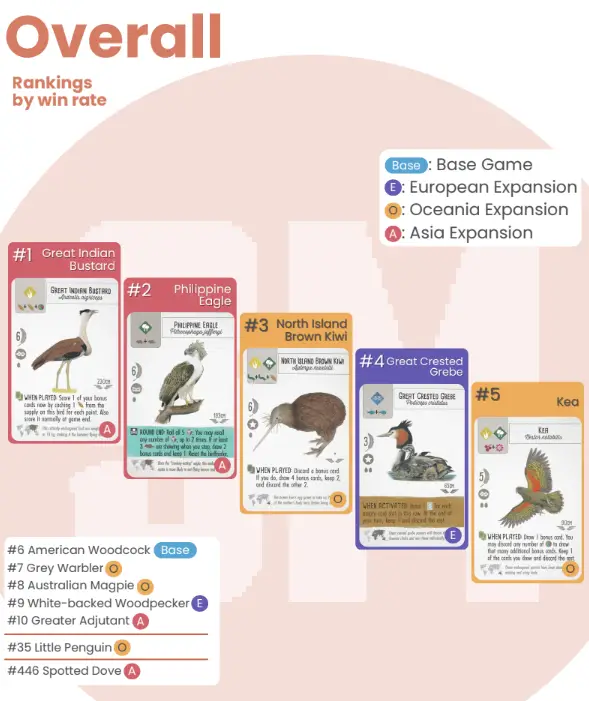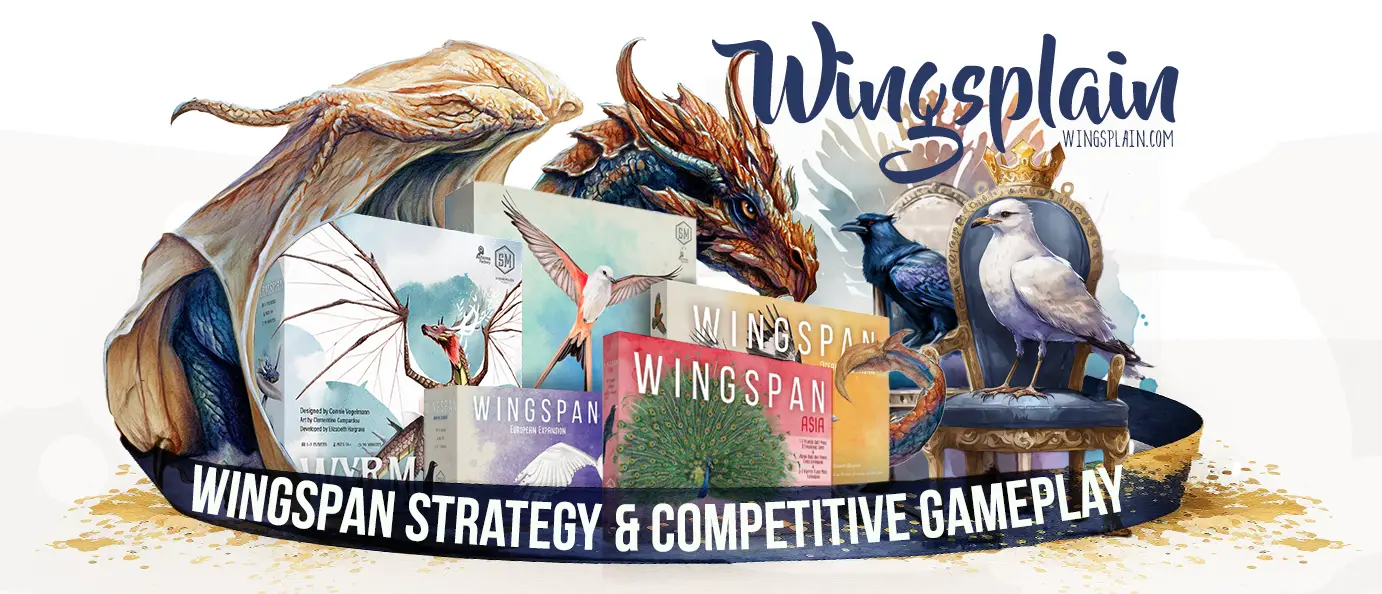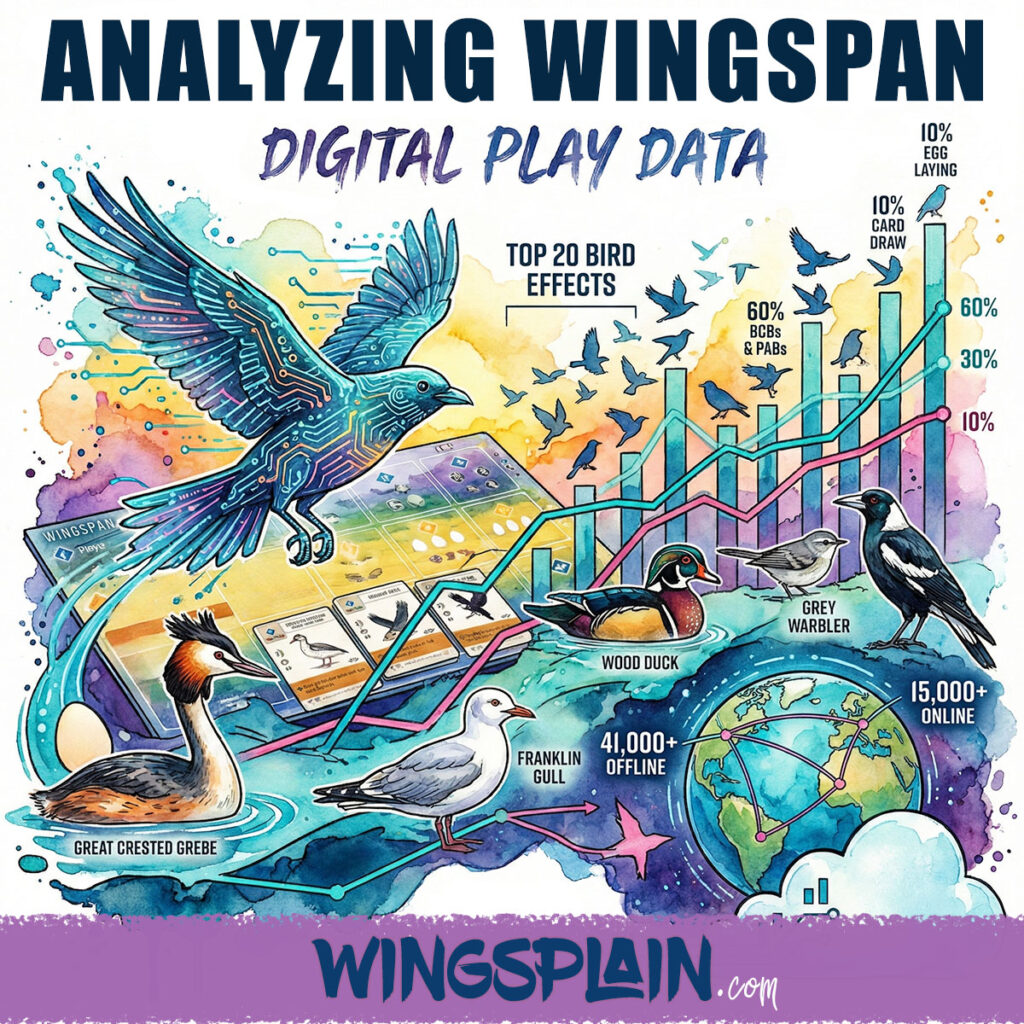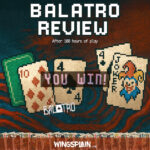Analyzing Wingspan Digital Play Data
On July 31st, 2025, Stonemaier Games published the article, “One Month, Half a Million Plays of Wingspan Digital: What the Data Reveals”. This article contains infographics made by Chris Olsen. Chris’s report was shared by Stonemaier Games and can be viewed in full here. I would like to take a look at this information and interpret it from a competitive player’s perspective. The core information is directly from the app produced by Monster Couch.
Over 500,000 games were sampled. Over 41,000 unique offline players and over 15,000 unique online players were sampled. Already, we can begin to see a divide between casual offline gameplay and more competitive online gameplay.
There’s a lot of good information here, but I would like to focus on Bird Win Rates. The results are not what I would expect for certain birds. The data starts off with a look at the top 20 bird effects.
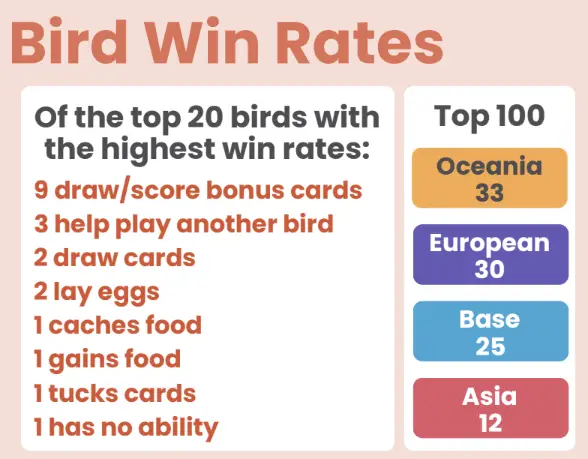
Here, there’s no surprise that Bonus Card Birds (BCBs) and Play Another Bird effects (PABs) are at the top, especially considering the Oceania metagame. Twelve of the top twenty birds (60%) are from these archetypes. Many games will end with players dropping big point birds (which I call “point bombs”) in order to secure their victory. This game state is amplified on the Oceania board, where Nectar and easier food availability allow birds to flood the board.
What does surprise me is that only 10% of the top twenty birds draw cards. Card drawing effects are probably the most important effects in the game right now, at least in the early game. You can’t drop a bunch of bombs in the late game if you don’t draw any over the course of your game. My first reaction is that we should see a lot more card drawing effects in a list of the Top 20 Most Winning Birds.
I think what we are seeing here is that it only really takes one strong card drawing effect to launch you into a game winning position. Think about it. How many games have you won off the back of a single Killdeer, Franklin’s Gull, White Stork, Wood Duck, Black-Throated Diver, or Ruddy Duck?
Conversely, late game strategy involves dropping the best big point birds over and over again, in large quantities. This is where Teal Powered PAB effects, such as Yellowhammer, can really shine. These effects are “bird spam” engines if managed properly. Although none of the Teal PABs make any of the lists.
Also a surprise, only 10% of the top twenty birds lay eggs. This seems pretty surprising at first, considering that the Oceania boards radically increase the power of egg laying birds such as Chipping Sparrow and Mourning Dove. These birds can lay eggs in the Forest, and this is incredibly powerful.
Egg laying Forest birds are often the critical lynchpin of the strongest Forest engines. Grassland egg laying birds also get a power boost on a board that produces fewer eggs. Egg laying powers seem to have less of an impact on this data than I would have expected. I suppose this makes sense given that the majority of players (41%) are using the Core Set boards.
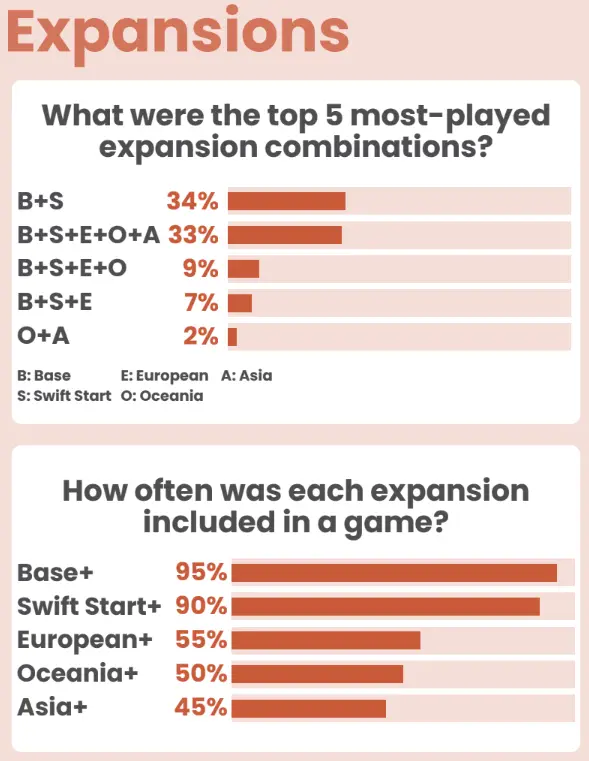
When looking at these comparisons, I think we need to remember that not all Wingspan wins are created equally. New players can beat their friends with a score of 70 while mainly playing their favorite birds. Competitive players can squeeze out an 85 point win despite bad draws all game. If these situations represent a majority share of the winning digital player base, these outcomes are going to have a bigger impact on a Top 20 list of this nature.
Hardcore competitive players tend to be in the minority in datasets like this, and I would expect their preferences to be underrepresented. After all, Wingspan was not designed to be a competitive tournament game. Optimizing the fun out of a game is a hazard many games face, but most games are going to have their dedicated optimizers regardless. I’m one of those people myself. Shameless plug for my Comprehensive Strategy Guide.
Base Game
The Top 10 list of the Core Set is full of point bombs and Franklin’s Gull. Where are the Ravens? Where’s Killdeer? Where’s Wood Duck? Maybe Wood Duck isn’t as big of a problem out of the box as many people claim it is. Perhaps the majority of players are just choosing to remove Ravens from the deck and not play with them at all. This option was first introduced in the Oceania rules, but I’m not sure if digital base game players are also able to select this option as well. The data seems to indicate that they can.
Update 11/26/25: It was pointed out to me on Reddit, and I later confirmed with a google search, that Ravens are automatically removed from the deck when players use online matchmaking. Here is a comment from a developer on the Steam forums.

This list is a bit of a conundrum. Barrow’s Goldeneye makes some sense if you think about its impact on a game with more than two players in a meta that encourages laying eggs. What about the cheaper and easier to play Cowbirds? Lazuli Bunting also makes a strange appearance. It’s a decent card and fits the bill for egg spam Grassland strategies, but I wouldn’t expect it to be a Top 10 winning base game bird.
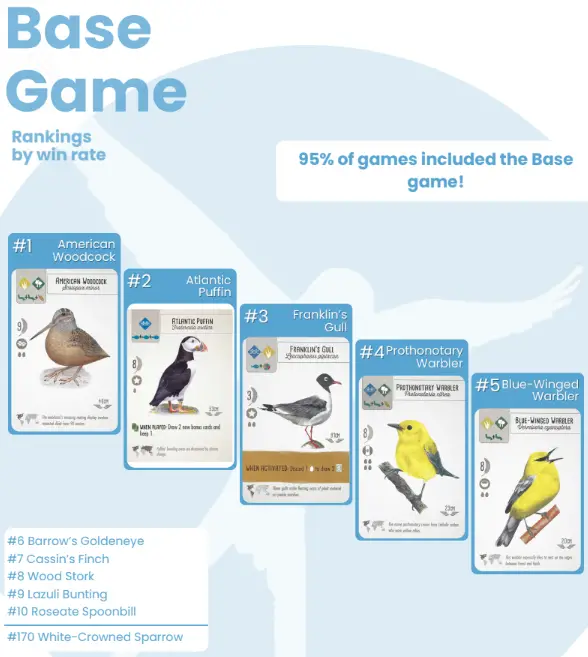
European Expansion
This list makes a lot more sense to me. Powerful card drawing birds in the Top 3, along with one of the best food gaining birds in the game, White-Backed Woodpecker. Common Cuckoo emerges as the most winning counter egg option, and European Goldfinch rounds out the Top 5 with its counter tuck power in a set where mass tucking exploded onto the scene. It’s really surprising to me that the cheaper and easier to play Snow Bunting is so much further down the list at ninth place.
It looks like the big eagles, Bonelli’s Eagle and Eastern Imperial Eagle, don’t win as many games as I would have expected. Eastern Imperial Eagle doesn’t even make the Top 10. White Stork’s “little brothers,” White-Throated Dipper and Black-Throated Diver are notably absent and can be considered some of the best card drawing birds in the game.
Common Goldeneye slides into the Top 10 here. It can be a handy egg laying power but I’ve personally gotten much more mileage out of Black Redstart and Lesser Whitethroat.

Oceania Expansion
This list reminds me why I don’t make a Top 10 Oceania Bird list. It would just be full of bonus card birds and that’s a bit boring as far as content goes, but it’s the truth. More PABs and more BCBs dominate this list, and that’s exactly what I would expect from Oceania. Grey Warbler and Australian Reed Warbler seem to be the PAB effects of choice. Their egg discount is clearly a factor here.
The screaming outliers are Australian Magpie at fourth and Pukeko at tenth. I almost never play these birds in a competitive environment, but it seems the general player base is making its preferences known here once again. Pukeko does make some sense as an egg laying Wetlands bird in a meta that is starved for eggs. I just wouldn’t expect it to win so much. It’s expensive and annoying to build around. Although food costs aren’t as big of an issue with Oceania.
Superb Lyrebird isn’t a surprise. With the rise of powerful Forest engines, it only makes sense that powers that copy opposing Forest birds rise along with them. It looks like Tui doesn’t win as often and managed to get beat out by Pukeko.
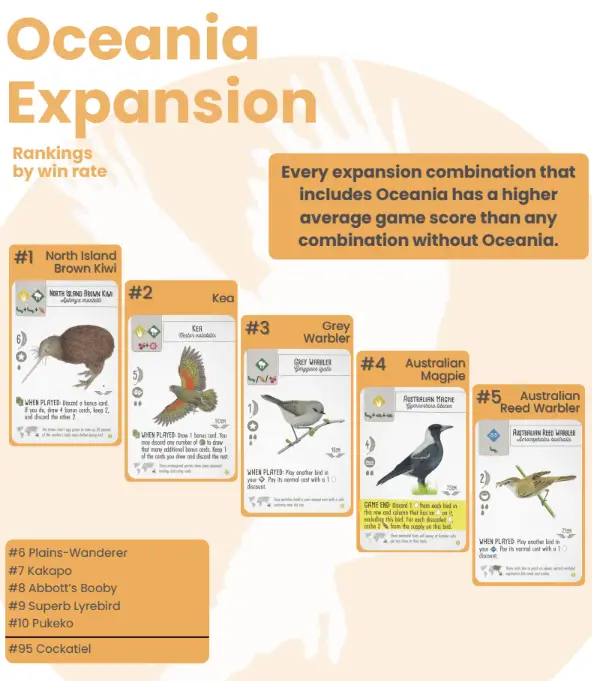
Asia Expansion
In a post-Oceania world, we see more of the same from Wingspan Asia. It’s no surprise that “Indian Busted” is at the top of the list with its incredible power. I’m a little surprised to see “Philly Eagle” at second, but it seems that the player base is on the same page as I am.
I’ve long theorized that Bustard and Philly are going to steal a lot of games from people and leave that memorable sting in their wake. Especially when the bonus card Endangered Species Protector is involved.
I’ve developed the opinion that Philly Eagle is almost a mandatory play for me, just for the random chance it steam rolls your opponents. The fact that its power is tacked onto a 6 point body and only costs two food makes it an acceptable resource investment in most games. This is a testament to the current power level of Bonus Cards.
Asian Koel and Violet Cuckoo break the rules for their archetype, allowing you to exceed the printed nest capacity of the bird you’re laying eggs on. They are the only counter egg powers in Asia, and they both make an impact. I’m not surprised to see them on this list. Especially given the trend that this archetype has some representation on every list except Oceania’s.
Sri Lanka Blue Magpie is an obvious inclusion as well. We even seen a passive card drawer slide into the tenth place slot with Brambling.
Common Tailorbird is the outlier bird on this list. It can be hard to build around, but I admit the appeal of solving this bird’s puzzle within a game of Wingspan. I wouldn’t expect it to be the fourth most winning Asia bird, though. Chris notes that Asia had only been out for a month, and it was included in half of all games played when the data was collected. That’s a lot of people taking the Tailorbird for a spin.
Update 11/23/25: It was pointed out to me that the Tailorbird’s presence on this list is likely due to people chasing the “Tailored Fit” achievement that requires you to lay 15 eggs at once with it’s power. I agree, this would explain things.

All Expansions Combined
Once again, I am perplexed. The Power 4 don’t even make the cut. No Wood Duck or White Stork either. Great Crested Grebe represents all card drawing birds on this list. Kea at fifth surprises me, but I guess a lot of players have extra food laying around to look at extra bonus cards and are enticed by the option.
Australian Magpie makes another baffling appearance. It seems players really love setting this bird up for victory. The rest of the list is the expected point bombs and PAB effects. Pink powers don’t make the cut when stacked up against everything. Little Penguin, a darling in the community, gets a special shout out here at 35th place.
American Woodcock represents the blank big point birds, and Grey Warbler represents the PAB effects. White-Backed Woodpecker emerges as the most winning food gaining bird, beating out the notorious Ravens.
